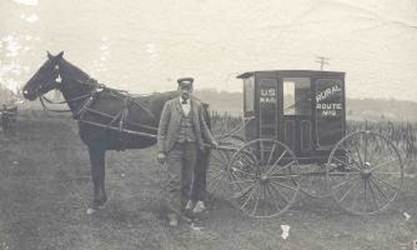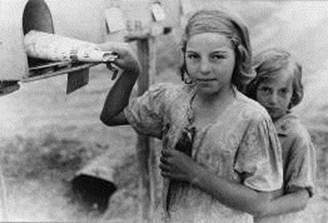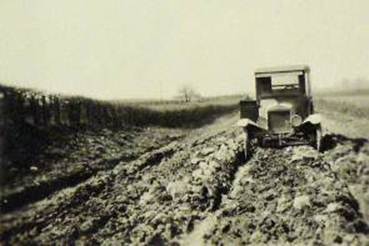Rural free delivery
In 1890, nearly 41 million people — 65 percent of the American population — lived in rural areas. Although many city dwellers had enjoyed free home delivery since 1863, rural citizens had to pick up their mail at the Post Office, leading one farmer to ask: “Why should the cities have fancy mail service and the old colonial system still prevail in the country districts?”[1]
John Wanamaker, who served as Postmaster General from 1889 to 1893, was a merchant who became one of the most innovative and energetic people ever to lead the Post Office Department. He thought it made more sense for one person to deliver mail than for 50 people to ride into town to collect their mail. He cited business logic and social philosophy as reasons to give rural dwellers free delivery. Businesses could expand their markets. Rural customers paid the same postage rates as city people. Rural people needed the important information provided by newspapers yet did not always have time to walk or ride to the Post Office. Young people might stay on the farm if correspondence and magazines eased their isolation.
“I think the growth of the Farmers’ Alliance movement and the other farmers’ movements in the past few years has been due to this hunger for something social as much as to anything else,” Wanamaker wrote in 1891.[2] He proposed that rural customers receive free delivery.
In January 1892, Congressman James O’Donnell introduced “A Bill to Extend the Free Delivery System of Mails to Rural Communities,” but the House Committee on Post Office and Post Roads balked at the proposed $6 million price tag. An amendment bringing the figure down to $100,000 also was rejected.
A year and two months later, on March 3, 1893, a bill introduced by one-term Georgia Congressman Tom Watson passed. It appropriated $10,000 for experimental rural free delivery. On March 6, 1893, Wilson S. Bissell was sworn in as Postmaster General. He did not pursue the experiment, citing the pressure of more important concerns and the need for at least $20 million to inaugurate rural free delivery, a figure later identified as a guess. Instead, he recommended establishing additional Post Offices where needed.
Bissell was succeeded by William L. Wilson on March 1, 1895. Wilson agreed with his predecessor that rural free delivery was not practical but was willing to attempt the experiment if Congress made money available. That year, Congress appropriated $20,000 for the experiment and another $10,000 in 1896, bringing the total to $40,000 — enough for the Post Office Department to begin its rural free delivery experiment.
On October 1, 1896, rural free delivery (RFD) service began in Charles Town, Halltown, and Uvilla in West Virginia, Postmaster General Wilson's home state. Within a year, 44 routes were operating in 29 states.
Just five days before Christmas in 1899, the Post Office Department decided to experiment with extending RFD across an entire county. Postmaster General Charles Emory Smith ordered that 63 small Post Offices and the routes of 35 star route contractors and mail messengers be discontinued and that rural free delivery be established in their place in Carroll County, Maryland. County-wide delivery proved viable.
Judged a success, rural free delivery became a permanent service effective July 1, 1902. The word “free” was dropped in 1906, since it was understood.

During the six experimental years before rural delivery became a permanent service, customers sent more than 10,000 petitions asking that routes be established. The Department had time to evaluate the extent to which RFD could replace small, fourth-class Post Offices and star routes, whether it could be used to offer services such as money orders, and what national RFD service would cost. The Department also had an opportunity to see what else was needed to make the service successful: good roads, standardized mailboxes, and a “great army of rural carriers” — about 8,500 in 1902. The Post Office Department claimed that, “as a class there are no more faithful employees in the Government service.”[3]
The backing of the National Grange, National Farmers’ Congress, and State Farmers’ Alliance was important to rural delivery’s establishment and success, as was the enthusiastic response of rural customers. Although one Kansas farmer expressed concern that rural people would become lazy if they did not have to pick up their mail, more typical were reactions such as those of the Colorado woman who was glad to “have our mail fresh instead of stale” and the Arizona citizen who wrote:
I am more than ever proud of being an American citizen. … I live three and a half miles from the Tempe post-office, and have been sick for a week past, yet my mail is brought to my door every morning, except Sunday. … It looks as if “Uncle Sam” had at last turned his eye in our direction.[4]


Rural free delivery spurred road improvement. Passable roads were a requirement of the service.
Farmers helped by putting out boxes for the rural carriers — everything from lard pails and syrup cans to old apple, soap, and cigar boxes. Postal officials decided a standardized box would improve service and, in 1901, asked manufacturers to design boxes to the following specifications:
- The box must be made of metal, 6 by 8 by 18 inches, and weather-proof.
- Boxes should be constructed so they can be fastened to a post at a height convenient to the carrier without alighting.
- Keys for customers' boxes should be easy to use by a carrier with “one gloved hand in the severest weather[5]
Manufacturers stenciled the words “Approved by the Postmaster-General” on satisfactory boxes. In 1902, the Post Office Department required customers to have these boxes in order to receive rural free delivery. Boxes could be square, oblong, circular, or semicircular but had to protect mail from rain, snow, and dust.

Rural carriers sold stamps and money orders, registered letters, and, in short, served as traveling Post Offices. They were the vanguard for delivery in suburban areas, a “middle territory, neither distinctly city nor rural in character” first mentioned by the Post Office Department in its Annual Report of 1902, with Bridgeport, Connecticut, cited as an example.[6] Rural carriers served suburban areas until these areas were annexed by an adjacent city postal district. Carriers supplied their own transportation — usually horses and wagons until, in 1929, the Post Office Department noted that improved roads had led to “almost a complete change in rural delivery from horse-drawn vehicles to motor cars.”[7]
Although rural carriers could deliver packages weighing up to four pounds, by law the Post Office Department could not deliver heavier packages, which had to be mailed using private express companies. Beginning in 1904 the Department asked Congress for authorization to experiment with the delivery of larger packages. In 1911, Postmaster General Frank H. Hitchcock recommended that Congress allow such service in rural and urban areas and requested a total of $150,000 for such an experiment, with the thought of paving the way for a general Parcel Post.
The increase in the number of rural routes led to a decrease in the number of small Post Offices. In 1901, the Post Office Department operated the largest number of Post Offices in American history, 76,945. The next year, there were 1,000 fewer Post Offices, and the number continued to decline.
In 2012, nearly 41 million homes and businesses were served by the Postal Service’s rural letter carriers.
HISTORIAN
UNITED STATES POSTAL SERVICE
AUGUST 2013
[1]Annual Report of the Postmaster General, 1891, 84.
[2] Ibid., 1891, 86.
[3] Ibid., 1902, 129.
[4] Ibid., 1897, 112–114.
[5] Ibid., 1901, 122. Locks on rural mailboxes have always been optional; initially carriers used master keys to open locked boxes. Since May 28, 1981, rural carriers have delivered mail into locked boxes through slots.
[6] Ibid., 1902, 101.
[7] Ibid., 1929, 26.
